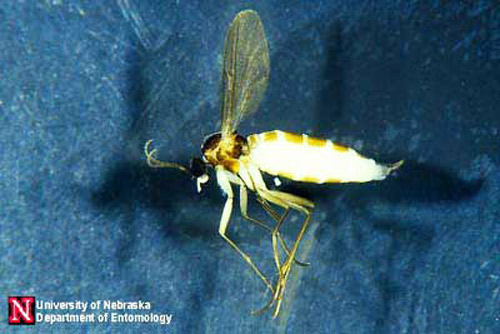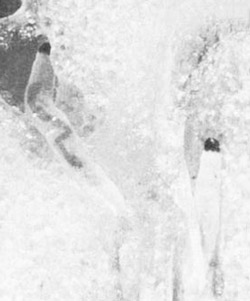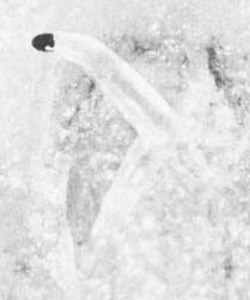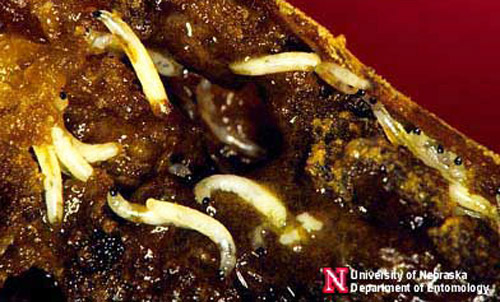common name: darkwinged fungus gnats
scientific name: Bradysia spp. (Insecta: Diptera: Sciaridae)
Introduction - Synonymy - Distribution - Description - Identification - Bionomics - Management - Selected References
Introduction (Back to Top)
Most species of darkwinged fungus gnats (Sciaridae) feed on fungi and decaying organic matter and are not considered economic problems. A few species, however, attack healthy tissue of such economic plants as potatoes, wheat, red clover, alfalfa, cultivated mushrooms, pine seedlings, and various ornamentals, including tulip bulbs, ferns, begonias, coleus, geraniums, cacti, young orchids, areca palm, and dracaenas. Sciarids are a problem in Florida greenhouses, mostly concerning injury to plants, but large numbers of flying gnats can be an occasional nuisance to workers.
Some growers have had difficulty achieving adequate control of fungus gnats, and more information is needed on effective insecticides, dosage rates, methods of application, and possible phytotoxicity.
Synonymy (Back to Top)
Sciaridae was formerly a subfamily in Mycetophilidae, and, for a short time, sciarids were called lycoriids (Lycoriidae). Many of the species formerly in genera Sciara and Neosciara are now in the genus Bradysia.
Distribution (Back to Top)
Steffan (1966) reported that Bradysia was represented by 65 species in North America and is the largest genus in the family in North America and Europe. It also is found on all other continents and on most of the major islands. In the USA, the species seem to be mostly in the northern and western states. Examples of Bradysia have been collected from all regions in Florida, but very few have been determined to species. Based upon the available literature, R.J. Gagne‚ USDA Systematic Entomology Lab, Washington, DC, identified sciarids from greenhouses in the Apopka area, Orange County, as Bradysia coprophila (Lintner) and Bradydia impatiens (Johannsen). He also identified Bradysia coprophila from Punta Gorda, Charlotte County, and Gainesville, Alachua County.
Description (Back to Top)
Larvae: The larvae are white, slender, legless, with a black head and smooth semi-transparent skin revealing digestive tract contents, length when fully grown 1/4 inch (6 mm). There are no similar greenhouse pests.
Figure 1. Darkwinged fungus gnat, Bradysia coprophila (Linter), larvae feeding on cactus tissues. Photographs by Division of Plant Industry.
Figure 2. Darkwinged fungus gnat larvae feeding in rotten potato. Photograph by Jim Kalisch, University of Nebraska-Lincoln.
Adults: The adults are small, up to 1/8 inch (3 mm) delicate flies, dark brown body, dusky wings, small head, rounded, moderately prominent eyes that meet above the bases of the thread-like antennae, legs and wings comparatively long. Fungus gnat adults are about 1/8 inch long, spindly flies with long legs and long, thread-like antennae. They look more like tiny mosquitoes than common flies.
Figure 3. Adult darkwinged fungus gnat, Bradysia coprophila (Linter), from Steffen (1966) slightly modified.

Figure 4. Adult darkwinged fungus gnat. Photograph by Jim Kalisch, University of Nebraska-Lincoln.
Valley (1975) described behavior of adult sciarids. He wrote that when disturbed, the gnats run rapidly or take flight, which usually consists of short darting or hovering movements over a small area.
Identification (Back to Top)
In North America, the key to sciarid genera by Shaw (1953) has been superseded by Steffan (1966). Identification at the species level is difficult, identification is based primarily on males which must be cleared with NaOH or KOH and mounted on slides, a somewhat delicate procedure. The primary references are Johannsen (1912) and Pettey (1918), but as Steffan (1966) pointed out, many of the older descriptions are inadequate by current standards, and type material must be seen to insure accuracy of determinations.
Bionomics (Back to Top)
The bionomics of Bradysia impatiens are well treated in the two papers by Wilkinson and Daugherty (1970a and b), which were inspired by observations of Daugherty in 1965 that larvae of Bradysia impatiens attacked roots of soybean seedlings grown under aseptic conditions in a laboratory. They (1970a) reported that at 75°F (24°C) in the laboratory the average fecundity of a female was 75 eggs, and length of life cycle about 27 days; however, when temperatures were fluctuated to produce optimum development, the life cycle was about 19 days. Kennedy (1974) reported that the strain of Bradysia impatiens he worked with had greater fecundity and shorter mean developmental time (15.6 days at 77°F) (25°C) than the population used by Wilkinson and Daugherty.
Kennedy (1974) reported on the significance of fungi in survival and development of Bradysia impatiens, a fungus gnat found commonly in greenhouses of New York State. He reported that larvae of this species frequently feed on the root and stem tissue of many greenhouse plants. His experiments suggested that fungi provide an essential nutrient source for the larvae of B. impatiens, and that if fungi are in low supply in the immediate vicinity of a living plant, there is a tendency for the larvae to use the plant as an alternate food source.
Hungerford (1916) reported the life cycle of Sciara (=Bradysia) coprophila was 24 to 32 days from egg-laying to egg-laying adult female. Thomas (1931) presumably working with coprophila, wrote that the life cycle from date of egg laying to date of fly emergence was 18 to 23 days at 63 to 70°F (17 to 21°C). At lower temperatures, development time was longer. Both Hungerford (1916) and Thomas (1931) illustrated life history stages of Bradysia coprophila and plant damage caused by feeding. In Florida, the Florida State Collection of Arthropods has a record of Bradysia coprophila being a severe problem on Christmas cactus, Zygocactus truncatus Schum., at a research center in Apopka during August 1977. There also is a record of it damaging 50 percent of 1000 seedlings of longleaf pine, Pinus palustris, at Punta Gorda during February 1975. The collector, Charles W. Chellman, noted the larvae invaded the tap roots and fed on lateral roots near the soil line.
Management (Back to Top)
Sound crop culture denies fungus gnats the conditions necessary for development, reduces need for pesticides and promotes parasites. Fungus gnat problems may result from overwet conditions and diseased roots and should alert growers to poor culture. Potting media should be stored dry, and pots and production areas must be well drained. Fungus gnats can exist on soil fungi, algae under benches, and on damp mossy benches. Some growers apply hydrated lime to eliminate the fungal food source (Price 1997).
The best growers stress good water management, good root health and are prepared to use insecticides correctly when fungus gnats are not otherwise controlled. When such practices are followed, fungus gnats should not be a problem.
Most of the larvae are in the top inch of soil. Rogue out any old plants and rotting materials. Avoid overwatering plants, since fungus gnats require moist to very moist soil or substrate for development. Steffan (1966) reported that, in general, both commercial greenhouse firms and commercial mushroom growers, practicing good cultural techniques, sustain very few losses from direct sciarid injury.
Selected References (Back to Top)
- Hungerford HB. 1916. Sciara maggots injurious to potted plants. Journal of Economic Entomology 9: 538-549.
- Johannsen OA. 1912. The Mycetophilidae of North America, Part IV. Maine Agricultural Experiment Station Bulletin, 200: 57-146.
- Kennedy MK. 1974. Survival and development of Bradysia impatiens (Diptera: Sciaridae) on fungal and nonfungal food sources. Annals of the Entomological Society of America 67: 745-749.
- Pettey FA. 1918. A revision of the genus Sciara of the family Mycetophilidae (Diptera). Annals of the Entomological Society of America 11: 319-343.
- Shaw FR. 1953. A review of some of the more important contributions to our knowledge of the systematic relationships of the Sciaridae (Diptera). Proceedings of the Hawaiian Entomological Society 15: 25-32.
- Steffan WA. 1966. A generic revision of the family Sciaridae (Diptera) of America north of Mexico. University of California Publication Entomology 44: 1-77.
- Thomas CA. 1931. Mushroom insects: their biology and control. Pennsylvania State College Agricultural Experiment Station Bulletin, 270: 1-42.
- Valley K. 1975. Flies (Diptera) in greenhouses. Pennsylvania Department of Agriculture, Bureau of Plant Industry, Entomology Circular No. 5, In Regulatory Horticulture 1: 9-10.
- Wilkinson JD, Daugherty DM. 1970a. The biology and immature stages of Bradysia impatiens (Diptera: Sciaridae). Annals of the Entomological Society of America 63: 656-660.
- Wilkinson JD, Daugherty DM. 1970b. Comparative development of Bradysia impatiens (Diptera: Sciaridae) under constant and variable temperatures. Annals of the Entomological Society of America 63: 1079-1083.



